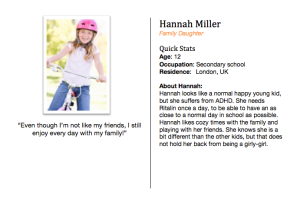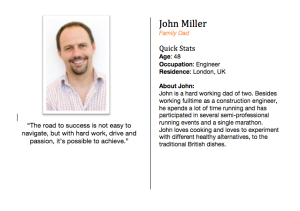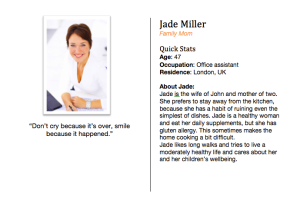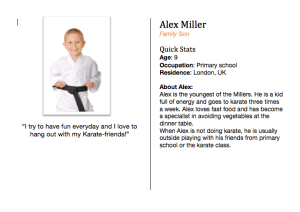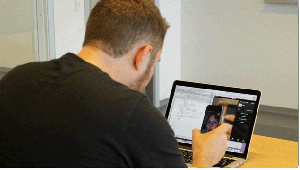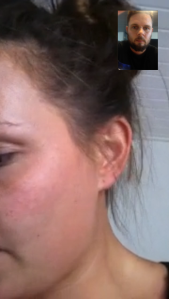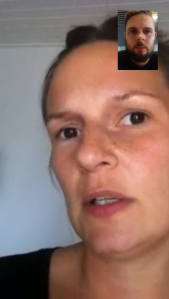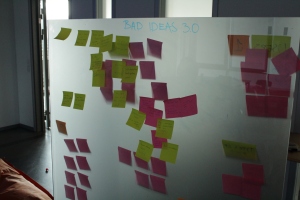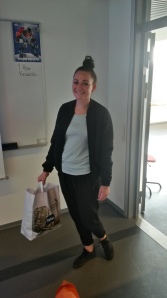From the outset we have tried to design our own design process. A large part of the theoretical basis for this is based on Löwgren and Stolterman’s (2004) idea of vision, operative image and specification.
“The three abstraction levels of the design process influence each other in a fully dynamic dialectical process.” (Löwgren and Stolterman, 2004, p. 17). The design process is by no means a linear process and we constantly jump between the micro and macro level where we interchangeably focus on the whole and the details in a dynamic process. (Löwgren and Stolterman, 2004, p. 16).
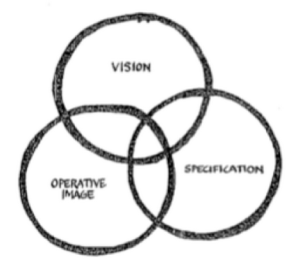
(Löwgren and Stolterman, 2004, p. 17.)
The basic idea is that the design process starts when an idea begins to take shape. The process continues until you outline concrete specifications that make up the foundation for a construction or building a product. The vision can be seen as the first organizing principle that guides the process and helps carry it forward (Löwgren and Stolterman, 2004, pp. 17-18). The next step is the operative image that is the first externalization of the vision, which is where the vision and it eventually develops into a specification that leads to the final product (p. 19-20). After specification is done, the construction of a prototype or product can begin.
In order to move from a vision through an operative image to a specification we use five overall design phases outlined by Löwgren and Stolterman (2004). They outline five overall parts or phases in a design process that goes through inquiry, exploration, composition, assessment and coordination. Inquiry can roughly be said to be a research phase, whereas you in the exploration phase examine the possible outcomes and solutions to the design problem. In the composition fase you increasingly use techniques to move from vision to operative image.
In the assessment phase you critically examine and evaluate the concepts and ideas we have produced. Coordination can be said to be a meta phase involves methods and techniques to facilitate the design process. (Löwgren and Stolterman, 2004, p. 64-65). The process is in no way linear and you jump between different phases in a dynamic and iterative process.
At this point in time we are half-way through the 24 hour challenge. Upon reading the design brief we immediately formed an initial vision which we have since developed and worked on specifying into an operative image. Our initial inquiry fase consisted of netnographic research methods with data collection on the internet (Kozinets, 2010) and we have also moved through exploration and composition fases involving methods such as Bad Ideas 3.0 (Silva, P., 2010) and brainstorming through and categorization of ideas through Affinity Diagramming (Snyder, 2003). We constantly iterate meaning we have done further research and we constantly asses our work, insights and findings. In order to move further along the process of generating an operative image, we plan on doing an inspiration card workshop in a couple of hours (Halskov & Dalsgaard, 2006).
Documentation and reflection through blogging
We are relying on our WordPress blog as a documentation as well as a reflection tool. We are documenting our ongoing process on our online blog https://sonsofive.wordpress.com. We document so we and the reviewers of OzCHI can get an overview of our design process and see how we achieved our results. Towards the end of the design process our blog will hopefully function as a soft draft for the paper that we are to hand in. However, the blog’s function as a collaborative tool between the Sons of Ive group members is just as important. We use the blog to categorize and specify our thoughts and ideas and negotiate about central aspects of the design process so we can be sure we are all on the same page and have a shared design experience.
The blog becomes a way to initiate what Schön calls reflection-on-action (Smith, 2001, p. 12) as a way to evaluate our work at all stages of the design process, and in this way live up to Schön’s idea of the reflective practioner that Löwgren and Stolterman also draw heavily on and use an integral part of their design process that we are using as a framework for our design process (Löwgren and Stolterman, 2004, p. 60). Through the blog we negotiate a uniform and suitable framing of the design situation instead of having different conceptions and a really messy situation (Schön, 1987, p. 4).
References
Halskov, K. & Dalsgaard, P. (2006): Inspiration Card Workshops. In Proceedings of DIS 2006.
Kozinets, R. (2010). Netnography, pp.58-73. 1st ed. Los Angeles, Calif.: SAGE.
Löwgren, J. and Stolterman, E. (2004). Thoughtful interaction design. 1st ed. Cambridge, Mass.: MIT Press.
Schön, D.A. (1987): Educating the Reflective Practitioner
Silva, P. (2010). BadIdeas 3.0: a method for creativity and innovation in design. pp.154–162.
Smith (2001) : Donald Schön: learning, reflection and change pp. 1-19.
Snyder, C. (2003). Paper prototyping. 1st ed. San Francisco, Calif.: Morgan Kaufmann, Elsevier Science.
